The answer from las3rjock, which somehow is the answer accepted by the OP, is incorrect--the code doesn't run, nor is it valid matplotlib syntax; that answer provides no runnable code and lacks any information or suggestion that the OP might find useful in writing their own code to solve the problem in the OP.
Given that it's the accepted answer and has already received several up-votes, I suppose a little deconstruction is in order.
First, calling subplot does not give you multiple plots; subplot is called to create a single plot, as well as to create multiple plots. In addition, "changing plt.figure(i)" is not correct.
plt.figure() (in which plt or PLT is usually matplotlib's pyplot library imported and rebound as a global variable, plt or sometimes PLT, like so:
from matplotlib import pyplot as PLT
fig = PLT.figure()
the line just above creates a matplotlib figure instance; this object's add_subplot method is then called for every plotting window (informally think of an x & y axis comprising a single subplot). You create (whether just one or for several on a page), like so
fig.add_subplot(111)
this syntax is equivalent to
fig.add_subplot(1,1,1)
choose the one that makes sense to you.
Below I've listed the code to plot two plots on a page, one above the other. The formatting is done via the argument passed to add_subplot. Notice the argument is (211) for the first plot and (212) for the second.
from matplotlib import pyplot as PLT
fig = PLT.figure()
ax1 = fig.add_subplot(211)
ax1.plot([(1, 2), (3, 4)], [(4, 3), (2, 3)])
ax2 = fig.add_subplot(212)
ax2.plot([(7, 2), (5, 3)], [(1, 6), (9, 5)])
PLT.show()
Each of these two arguments is a complete specification for correctly placing the respective plot windows on the page.
211 (which again, could also be written in 3-tuple form as (2,1,1) means two rows and one column of plot windows; the third digit specifies the ordering of that particular subplot window relative to the other subplot windows--in this case, this is the first plot (which places it on row 1) hence plot number 1, row 1 col 1.
The argument passed to the second call to add_subplot, differs from the first only by the trailing digit (a 2 instead of a 1, because this plot is the second plot (row 2, col 1).
An example with more plots: if instead you wanted four plots on a page, in a 2x2 matrix configuration, you would call the add_subplot method four times, passing in these four arguments (221), (222), (223), and (224), to create four plots on a page at 10, 2, 8, and 4 o'clock, respectively and in this order.
Notice that each of the four arguments contains two leadings 2's--that encodes the 2 x 2 configuration, ie, two rows and two columns.
The third (right-most) digit in each of the four arguments encodes the ordering of that particular plot window in the 2 x 2 matrix--ie, row 1 col 1 (1), row 1 col 2 (2), row 2 col 1 (3), row 2 col 2 (4).
